
And the winners are…
By Carolyn Cooper, Carol Neshevich
Business Operations Bake & Snack Food Beverages Confectionery Health & Wellness Specialty FoodsThe 2016 Leadership Awards

It is our pleasure to partner with Food in Canada once again in sponsoring the 2016 Leadership Awards. The companies that 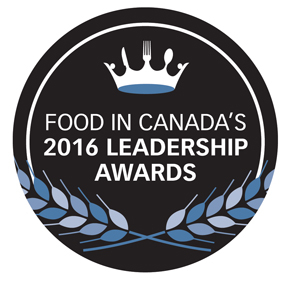 have been selected this year are great examples of industry leaders that have demonstrated a significant contribution to the food and beverage industry, and are well deserving of the recognition. Their achievements in the areas of growth, innovation, stewardship, community involvement, and health and wellness, are a credit to their ownership, management and employees. We are truly proud to have this opportunity to recognize them this year.
have been selected this year are great examples of industry leaders that have demonstrated a significant contribution to the food and beverage industry, and are well deserving of the recognition. Their achievements in the areas of growth, innovation, stewardship, community involvement, and health and wellness, are a credit to their ownership, management and employees. We are truly proud to have this opportunity to recognize them this year.
Consumers here in Canada and around the world continue to look for value and improved quality when making their food and beverage choices. As such, producers must provide products that retailers believe will meet these evolving consumer demands. To do so, producers must understand the end consumers’ needs and invest in new markets and offerings to meet them. Notably, this also creates opportunities for producers to positively impact their communities and markets by producing healthy products in an environmentally friendly way.
Innovation is critical to success in the industry today. As you will see, haskapa clearly demonstrates an innovative approach to its business and well represents the industry from an innovation perspective. Equally as impressive are the measures and initiatives that Nestlé Canada has undertaken from a sustainability standpoint, an aspect of doing business in today’s world that has ever-increasing importance.
For its part, Real Food for Real Kids strives to “enable and inspire healthy eating,” proudly demonstrating how companies in the industry can make a real difference. Similarly, the community involvement and industry leadership exemplified by Steam Whistle Brewing clearly shows how individual producers can positively impact the industry as a whole. Finally, the impressive growth recently experienced by G.E. Barbour is a credit to the company’s strategic and aggressive approach to managing its business; it is a true model of success.
These companies are inspirational examples of the strength of the industry in Canada and the ability of producers to meet the significant challenges that businesses face in today’s world. As a firm dedicated to serving the food and beverage industry, we at Grant Thornton feel very privileged to recognize these 2016 industry leaders.
Jim Menzies
National Leader, Food & Beverage Industry
Grant Thornton LLP
www.GrantThornton.ca/Manufacturing
Nestlé Canada Inc. – Stewardship Award
By Carol Neshevich
Stewardship and sustainability have been important to Nestlé for 150 years, according to Shelley Martin, president and CEO of Nestlé Canada Inc. – even if those weren’t the exact words they used for it back when the now-global company was first established in Switzerland in 1866.

Shelley Martin, president and CEO, Nestle
“It’s our 150th anniversary, and for any company to be around for that long and to be this successful, sustainability needs to be foundational,” says Martin. “At Nestlé we call it creating shared value, and it’s integrated into everything we do. So from our very early days of Henri Nestlé developing the first infant formula to save his neighbour’s baby, to making sure we have sustainable resources in terms of cocoa and coffee, to making sure we leave a positive footprint everywhere we are in 130 countries around the world, it is what we do.”
From an environmental footprint perspective, Nestlé has committed to zero waste for disposal by 2020, along with a 35-per-cent reduction in greenhouse gas emissions and a 35-per-cent reduction of water usage in its operations between 2010 and 2020. Nestlé Canada Inc. is well on its way toward this goal, reducing greenhouse gas emissions by seven per cent across Nestlé Canada between 2012 and 2014, which includes an 8.2-per-cent reduction at the Sterling Road Chocolate Factory in Toronto and a 10-per-cent reduction at the company’s Ice Cream Factory in London, Ont.; and reducing water usage by 22.5 per cent across Nestlé Canada between 2012 and 2014, including a 25-per-cent reduction at the Sterling Road Chocolate Factory and a 22.4-per-cent reduction at the London Ice Cream Factory. Both the Sterling Road factory and the London factory have already achieved zero waste to landfill.
Sustainable sourcing is also something Nestlé takes seriously. “We have developed our Responsible Sourcing Guidelines and we use these to ensure that the raw materials we are buying are both sustainable and responsible,” says Martin. For coffee production, for instance, Nestlé has rolled out the Nescafé Plan to help coffee farmers rejuvenate their plantations, multiply the yield on existing land and increase their income. And on the chocolate side, Martin points again to the Sterling Road Chocolate Factory as a good example of sustainable sourcing: “100 per cent of the chocolate produced in that factory is certified for sustainability, and it is sourced within our own Nestlé Cocoa Plan, which is a plan we have in terms of supporting farmers and sustainability of cocoa within the Ivory Coast,” she says. “So all of the product coming out of that factory is sustainable chocolate.”
Packaging plays a major role in Nestlé’s stewardship practices as well. “We’re always looking at ways to reduce the packaging and its impact on the environment,” says Martin. “We have an internal design tool that we use to determine which packaging design is the most environmentally friendly; this looks at it from the raw materials used in packaging all the way to consumer use, so we can work with our packaging team to determine the most efficient design.”
For example, the company’s Eco-Shape 500-mL water bottle is one of the lightest in the industry and contains 60 per cent less plastic than the bottles Nestlé used in 2000. And in 2015 it moved to a smaller carton for Delissio pizza boxes, allowing paperboard savings of 4.4 per cent annually. That same year, the Nestlé Sundae Cups were moved from a case to a tray and film, providing a 29.3-per-cent paperboard savings (61,000 kg annually).
While Martin admits it takes great effort to maintain sustainability commitments in such a large organization, she says the rewards are countless. “The first obvious thing is that we’re leaving a positive imprint on the communities in terms of the environment, and the people, and the ecosystems,” she says. “But other positives include watching [our employees’ response]. We have 3,500 employees in Canada, and seeing their engagement, their concern, their passion, their commitment to our journey of continuous improvement in everything we do, including sustainability, has been great…It builds momentum and it builds pride, and that’s a real reward.”
Real Food for Real Kids – Health and& Wellness Award
By Carol Neshevich
Lulu Cohen-Farnell and her husband David Farnell are on a mission. As owners of Real Food for Real Kids (RFRK), a Toronto-based company that prepares and delivers healthy meals and snacks to schools, daycares and camps across the city, they see their business as more than just a business – it’s a calling, really, to train children and their parents to make healthy eating an integral part of their lives.
“We understand the responsibility we have in shaping the trajectory of any given child’s palate towards healthy,” says Farnell, who is also the company’s CEO. “And we find it absolutely essential for them to develop familiarity (with varied tastes) early, which we all know leads to greater likelihood of acceptance through life.”
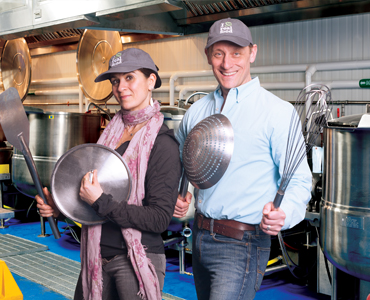
Real Food for Real Kids co-owners Lulu Cohen-Farnell and David Farnell.
To that end, their menus are specifically designed to expand children’s palates. In contrast to the chicken nuggets and mini pizzas that have been known to dominate daycare menus, RFRK entrées range from ratatouille with organic tofu to white bean curry or fish bolognese. “There’s this whole notion here in North America that kids’ food has to be different from grown-up food,” says Cohen-Farnell, whose title is founder, president and CFIO (Chief Food Innovation Officer). “In other countries where real food has a major place in the culture, and kids are exposed to a number of flavours, textures, spices and herbs from a young age, the children are more adventurous eaters.”
Unlike many of their competitors who rely on large global food distributors and simply reheat the food, RFRK has its own kitchen that’s equipped to make food from scratch. “In order to ensure healthy, delicious and nutritious food, you need to be in control of your ingredients, and the only way to do that is to have a from-scratch kitchen,” says Farnell. “We produce everything in-house that we possibly can, so that means all the proteins, the grains, the marinades, sauces, dips, dressings – we even make our own sugar-free ketchup,” he adds, noting that there are some items they simply can’t make themselves, such as crackers, cheese and yogurt (due to dairy regulations), but in those cases they make sure all ingredients conform to RFRK’s quality standards.
And those standards are quite exacting. “For everything from the grass-fed beef we serve to the sea salt we use in our cooking, we investigate every single ingredient that comes into our kitchen,” says Cohen-Farnell. “We put an enormous amount of questions to the supplier, wanting to know what the animals are fed and how they are treated, where the salt is coming from, how it’s been processed. Our focus is on local sustainably grown food as much as possible…we avoid GMOs, artificial colours and preservatives. We prefer to work with growers and suppliers who are close to us so we can visit their plants, visit the farmers, and make sure we share the same values and ethics.”
Besides producing and providing healthy food for kids, RFRK’s mission includes an educational component as well. “We call ourselves an edu-caterer,” says Cohen-Farnell. “We do a lot of parent seminars. I do talks at different conferences. We’ve also done kids’ workshops where we taught the kids about fruits and vegetables.”
In addition to the 85 staff employed at the Real Food kitchen in downtown Toronto, RFRK also hires about 100 contractors called Real Food Lunch Club Coaches who serve lunches in elementary schools. Trained by RFRK, the “coaches” are also expected to be food educators, telling the kids nutritional facts and stories about the food served, and encouraging them to try everything.
Even though the world may be starting to move toward a greater desire for clean and healthy food overall, maintaining a strong commitment to health and wellness isn’t always easy in a world where the bottom line is often king. “It’s really been a huge challenge to be entrepreneurs who are mission driven, with a social mission and a purpose that goes beyond profitability,” says Farnell. “It’s hard. But it’s extremely important to us. It goes towards helping kids and parents have a greater likelihood of high health outcomes throughout their lives.”
haskapa – Innovation Award
By Carolyn Cooper
Liam Taylor recalls the early days of the haskapa brand, when the market for haskap berries in Canada was virtually non-existent: “One of the elements that we discovered was that no one got excited about the haskap berry until they could actually taste the haskap berry, and taste the products of the haskap berry.” That’s why the company began researching and developing products almost immediately says Taylor, commercial director for LaHave Forests, Inc. (operating under the brand haskapa).
As the first commercial brand of haskap berries in North America, haskapa has had to innovate in everything it does, from harvesting to processing and marketing. “By constantly innovating, constantly bringing out new products, that’s how you keep consumers engaged, especially when you’re building a brand,” explains Taylor. From its initial 11-acre orchard, planted in 2011, the company is on track within the next 18 months to have more than 140 acres of haskap berries growing and more than 100 tonnes processed. “Our orchards are only five years old, so they’re just beginning to come to full yield,” explains Taylor, noting that the company initially brought in berries from Quebec, Saskatchewan and Poland. “But we created the products here, using all local knowledge and processing, and we now have products that get people excited, people then want to put plants in the ground, which means we can get local berries to make products.”
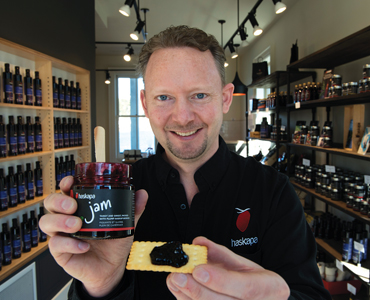
haskapa commercial director Liam Taylor.
A native of Japan, the haskap berry was introduced to Canada in the late 1960s and used mainly as an ornamental plant rather than an edible crop. The dark blue fruit resembles an elongated blueberry, but is a member of the honeysuckle family. According to haskapa, the berries are high in anthocyanins, vitamin C, phenolic compounds and other antioxidants, with a flavour reminiscent of “a zingy combination of blueberry and raspberry with a hint of elderberry.”
Because it is new to the Canadian market, Taylor says it was essential that the company support ongoing research on the haskap berry. Working with Dalhousie University, the company is engaged in a number of studies aimed at optimizing harvesting and freezing processes to maximize the bioactive content of its products. Another study is looking at the chemopreventative properties of polyphenols on cancer cells. “There’s a lot of hype around berries and antioxidants,” says Taylor. “We feel we’re doing our due diligence, our research, to be able to really stand behind our products. We’re very aware that we have to be market leaders – we have to establish our brand as the premium brand of products out there that in many ways is going to set the bar. This is also key to the longevity of the brand.”
In 2014 haskapa launched North America’s first haskap berry product line, including its award-winning juice, jam and dried berries. The line has since expanded to include haskap maple syrup, jalapeno relish, chutney, and even haskap berry gin, all made by processors in Atlantic Canada. In the coming year the company will introduce a health line featuring a pure haskap berry juice, powder and a haskap/chia mix. Developed with Newfoundland’s Sedna Nutra using its Refractance Window Drying process, the latter two products will maintain more than 90 per cent of the bioactives of the berries. A grocery collection including haskap green tea, herbal tea, cranberry sauce and a reduction will round out this year’s new products.
“Now we’ve completed our research, we’re happy that we have maximized the processing to such an extent that we’re comfortable launching our health products,” says Taylor, who notes that the company will make education on the haskap berry’s various health benefits a key part of its marketing message as it rolls out its products in the regional market, and then into Ontario. “In everything we do it’s absolutely key to explain to everyone what the haskap berry is, its heritage, and its potential health properties,” he says.
Steam Whistle Brewing – Community & Industry Leadership Award
By Carol Neshevich
For the folks who run Toronto’s Steam Whistle Brewing, being connected to the local community is simply a part of who they are. In fact, co-founders Greg Taylor and Cam Heaps often credit the company’s close ties to Torontonians and the city’s cultural scene for much of the craft brewery’s success. “If you don’t have a connection with the community, nobody will support your brand,” says Taylor. “Craft beer is all about local. Your most important customers are often the ones who live next door.”
To help foster those community ties, Steam Whistle sponsors more than 800 charitable, cultural and community events each year. In particular, the brewery tends to focus strongly on the arts. “On the branding side, there’s no question that it makes a lot of sense to connect with social leaders and folks who people look up to in the music industry, and so on,” says Taylor, noting that artists and supporters of the local cultural scene tend to be part of their key demographic. “We don’t have the resources to advertise extensively – and this was especially true when we first started – so what we did was take the little we had and start helping and supporting the arts community around us.”
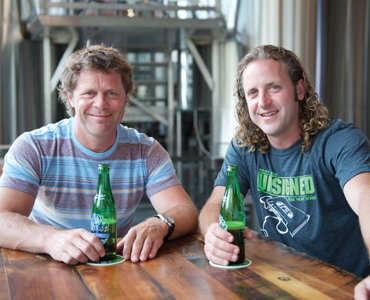
Steam Whistle Brewing co-founders Greg Taylor (left) and Cam Heaps.
When it comes to visual arts, the Steam Whistle Gallery (located in the brewery’s downtown Toronto headquarters) hosts a new art show every month to showcase the work of local artists. And on the music side, the brewery’s highly successful UNSIGNED concert series aims to showcase Canadian indie music talent, with all proceeds from the ticket sales going back into the arts community. To date, UNSIGNED has featured more than 100 independent acts and raised more than $75,000 for non-profits such as Artists Health Alliance, Music Ontario, and the Unison Benevolent Fund.
Charitable involvement is similarly a high priority for the craft brewer, with the Ride to Conquer Cancer being their biggest charitable cause. Donating more than 20,000 beers to the high-profile event each year, Taylor and Heaps see it as a great way to support an important cause while also raising the profile of the brand. “At the end of each ride, [participants] get a nice cold Steam Whistle,” says Taylor. “We have a big team that takes part too, and we sponsor a mile on the course. So people see our involvement in a genuine way because they see our staff right out there.” Much like its connection to the arts community, Steam Whistle also holds a solid place in the local cycling community – regularly offering free bike tune-up seminars and community rides, for example, among other initiatives – so a charitable event like this one is truly a natural fit for the brewery.
As another way to foster community connections, Steam Whistle puts a lot of effort into making its guided brewery tours fun and interesting. Their tours are so impressive, in fact, that Steam Whistle’s brewery has recently been recommended as a tourist destination in the Huffington Post, Toronto Star, Notable.ca, Trip Advisor and the Ontario Culinary Tourism Alliance’s website, among others. Their unique location (the brewery is housed in Toronto’s historic John Street Roundhouse, which is a Canadian National Historic Site that once functioned as CP Rail steam locomotive repair facility) also gives people a sense that the beer has a link to Canadian history, which causes proud Canadian customers to “psychologically connect with the brand,” according to Taylor.
For Steam Whistle, it’s not just about its own brand either – the brewery has a deep commitment to strengthening the Canadian craft beer industry as a whole. Heaps is currently chair of the Ontario Craft Brewers, an association of more than 50 small brewers in the province. They work hard to level the playing field for craft brewers competing against the large multinational beer companies. “Craft beer in Canada needs heroes, and we’re doing what we can to be one of those,” says Taylor, noting that he and Heaps strongly encourage other Canadian craft brewers to join associations to help strengthen the industry. “We don’t see it as something that simply sounds like a good idea; we see it as essential for the growth and health of craft beer in Canada.”
G.E. Barbour – Growth Award
By Carolyn Cooper
After almost 150 years in business, family-owned G.E. Barbour clearly has a history of long-term success. But it’s been in the last five years that the company has seen one of its greatest jumps in sales and volumes, thanks to its commitment to quality, service and building strong relationships with customers.
Founded the same year as Confederation, G.E. Barbour made a name for itself through sales of spices, baking extracts and the iconic East Coast brew King Cole Tea. The company was purchased by the Brenan family in the 1950s, and for the next four decades its various product lines continued to flourish throughout Atlantic Canada. By the 1990s the company had moved into private-label production and co-packing of nut butters, but growth wasn’t a focus.
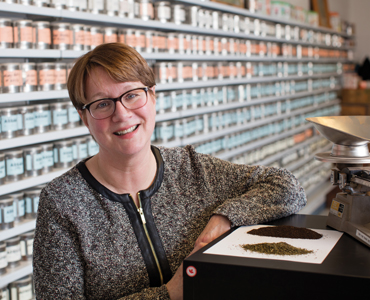
GE Barbour president Sylvia MacVey.
Then in 2011, after ownership was consolidated within the family, the company underwent a major turnover of senior management, allowing it to move forward with a new vision and strategy. After establishing itself as a reliable supplier of natural and organic food with an excellent food safety record, G.E. Barbour began focusing on selling its capabilities, and building private-label and co-packing partnerships with retailers and food producers in which “lowest cost” wasn’t the primary factor. Internally the company made significant investments in human resources, product development, supply chain and IT support.
“The big growth came from the nut butters in 2013,” recalls G.E. Barbour president and Brenan family member Sylvia MacVey. “We ended up right across the country, which was major growth for us.” MacVey admits a spike in commodity prices and quality and safety concerns in the category at the time meant Barbour’s, as a trusted manufacturer, was pushed into the limelight. “It was a little opportunistic, there’s no question, but we spent 2011 and 2012 getting ready for it, seeing those opportunities in the market, getting our ducks in a row so that when we started to pursue those opportunities we had the credentials to take us to the next level,” says MacVey.”
Today 80 per cent of Barbour’s sales come from private-label and co-packing of specialty and natural nut butters, says MacVey. Total volume was 5.7 million kg in 2015, compared to just 2.2 million kg in volume in 2011. Much of that growth has also come through exporting to the U.S. King Cole Tea is the company’s second-largest division, and still number-one in its category in the regional marketplace. Meanwhile, Barbour’s baking products lineup, including flavour extracts and popcorn seasonings, is its second-fastest growing division. “Success at G.E. Barbour really is about being able to achieve growth in all our divisions and still maintain a sense of family,” says MacVey. “To spread success from one division to another, so we can continue our growth and diversification – that’s very important.”
Because of the highly competitive nature of co-packing, MacVey says building strong relationships has been essential. “What also differentiates us is just how collaborative we are with our customers,” she adds. “We’re constantly looking at the trends. But most of what we’re doing is because the customer will come to us and say we’re looking for something interesting and innovative, and we’re really willing to work with them to find out exactly what that is. It’s about being open to new ideas.” MacVey also says investing in different certifications, and “differentiating ourselves by doing some really interesting things with flavours and formulas” will continue to set G.E. Barbour apart.
One struggle MacVey says the company continues to face is high commodity costs. “We’re trying to keep our costs down, and we want to make sure we’re achieving the value to pass onto our customers, understanding that we will never be the low-cost option,” she says. “That’s probably our biggest challenge – getting people to understand that although you could probably get a better-priced nut butter, our service and our quality are worth the little bit extra.”
Print this page